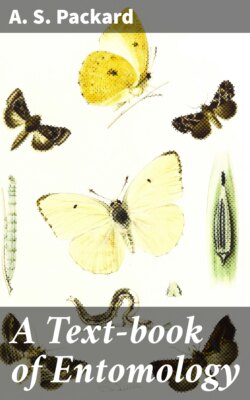Читать книгу A Text-book of Entomology - A. S. Packard - Страница 46
На сайте Литреса книга снята с продажи.
e. Development and mode of origin of the wings
ОглавлениеEmbryonic development of the wings.—The wings of insects are essentially simple dorsal outgrowths of the integument, being evaginations of the hypodermis. They begin to form in the embryo before hatching, first appearing as folds, buds, or evaginations, of the hypodermis, which lie in pouches, called peripodal cavities. They are not visible externally until rather late in larval life, after the insect, such as a grasshopper, has moulted twice or more times; while in holometabolous insects they are not seen externally until the pupa state is attained.
The subject of their origin is in a less satisfactory state than desirable from the fact that at the outset the development of the wings of the most generalized insects, such as Orthoptera, Termes, etc., was not first examined, that of the most highly modified of any insects, i.e. the Muscidæ, having actually been first studied.
In the course of his embryological studies on the Muscidæ (Musca comitoria and Sarcophaga carnaria) Weismann (1864) in examining the larvæ of these flies just before pupation, found that the wings, as well as the legs and mouth-appendages, developed from microscopic masses of indifferent cells, which he called “imaginal discs.” From the six imaginal discs or buds in the lower part of the thorax arise the legs, while from four dorsal discs, two in the meso- and two in the metathoracic segment, arise the fore and hind wings (Fig. 141.) These imaginal buds, as we prefer to call these germs, usually appear at the close of embryonic life, being found in freshly hatched larvæ.
